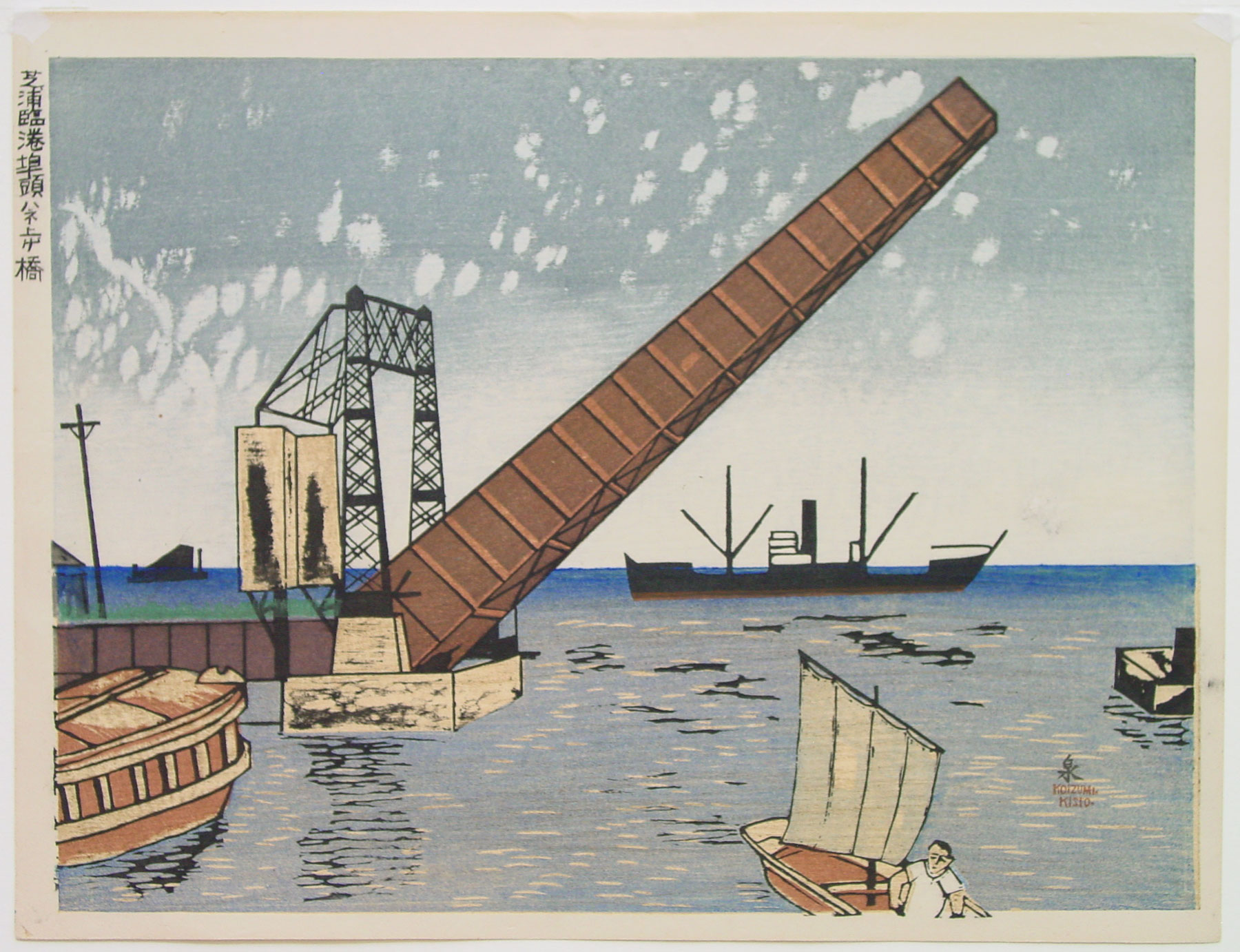About This Print
Number six of the one hundred prints that make up the series Showa dai Tokyohyakuzue (One Hundred Pictures of Great Tokyo During Showa). Koizumi startedthis series in 1928 and completed it twelve years later in 1940.For more information on this series see "The Series - One Hundred Pictures of Great Tokyo During Showa (Showa dai Tokyo hyakuzue)" under the artist's biography.
This print does not have the series title printed in the margin as is typically seen. It appears to be from the same blocks used for the Tokyo National Museum of Modern Art print shown below under Reference Images.
Source: Tokyo: The Imperial Capital Woodblock prints by Koizumi Kishio, 1928-1940, Marianne Lamonaca, The Wolfsonian-Florida International University, 2003, p.46
In March 1930, Tokyo celebrated the official completion of its reconstruction following the 1923 earthquake. In the days following the earthquake, Shibaura served as a landing place for incoming supplies and as a departure point for refugees.
It is likely that Koizumi produced the print to acknowledge the newly established Ten-Year Harbor Improvement Plan. Under the plan, Shibaura harbor would be dredged to allow ships of up to five thousand tons access to the port; new sea walls would be built to provide berths for large steamships. The ten-year plan would culminate in a grand exposition to commemorate the 2,600th anniversary of the imperial reign, highlighting the nation’s place among the great world powers, and serving as propaganda to promote the emperor and the nation.
Artist's Annotation
Source: MIT Visualizing Cultures website http://ocw.mit.edu/ans7870/21f/21f.027/tokyo_modern_02/annotation.htmlIn 1940, Koizumi created woodblock print charts containing print titles, dates, and comments for this series. His comment for this print follows:
“In the morning and evening the drawbridge was in the down position to accommodate freight trains."
Other Impressions - Reference Images for this Print
| The Drawbridge on the Rinkai Pier, Shibaura (No.6 of "One Hundred Scenes from Tokyo Metropolis in the Showa Period") National Museum of Modern Art , Tokyo website color woodcut on paper 28.0×37.5cm, inscribed(p) u.l.; sealed and signed(p) l.r. | Plate 4 from “Tokyo: The Imperial Capital Woodblock prints by Koizumi Kishio, 1928-1940” by The Wolfsonian-Florida International University |
Image from Tohoku University Repository - note great similarities to print composition,
suggesting this photo as the source of the print image.
Shibaura Pier and Tokyo Port Today
Source: Tokyo Tourism Info website http://www.tourism.metro.tokyo.jp/english/tourists/guideservice/toshikiban/ins13.htmlThe history of Tokyo Port is surprisingly new, opening in 1941. There had been many blueprints to develop Tokyo Port since the Meiji era, but none of them was realized due to opposing argument and/or financial difficulties. However, the Great Kanto Earthquake in 1923 destroyed the transportation network on the ground, then it became difficult to transport goods to Tokyo and urgently the Tokyo Port construction was carried out. The Hinode Pier and Shibaura Pier in 1925, Shibaura Pier in 1932 and Takeshiba Pier in 1934, were completed one after the other. Finally Tokyo Port was opened as an international trading port on May 20th, 1941 because of the acceleration of economic activities. Finally Tokyo Port was opened as an international trading port on May20th, 1941 because of the acceleration of economic activities.
Withthe post war reconstruction of domestic industry the Toyosu coal pierand Harumi Pier were constructed and after 1965, it adapted containertransportation. Tokyo Port took this occasion to establish its positionas an international trading port.
Print Details
| IHL Catalog | #109 |
| Title | Drawbridge at Shibaura Shibaura hane-age-bashi 芝浦臨海埠頭ハネ上ゲ橋 |
| Series | One Hundred Pictures of Great Tokyo in the Showa Era Showa dai Tokyo hyakuzue 昭和大東京百図絵 |
| Reference Number | #6 (artist's annotated portfolio list from c. 1940) |
| Artist | Koizumi Kishio (1893-1945) |
| Signature | Koizumi Kishio (Roman letters) and Izumi 泉 in image |
| Seal | |
| Publication Date | September 1930 |
| Edition | unknownedition. Plate in Wolfsonian catalog has series title in left marginand no signature or seal. |
| Publisher | likely self-published; some sources list publisher as Asahi Press (see "The Publisher of the Series" under the artist's bio Koizumi Kishio.) |
| Impression | excellent |
| Colors | excellent |
| Condition | good - rubbed and thinned area (approx. ¾” in diameter)to right of black freighter; two ¼” tears center of top marking, thinning top edge. |
| Miscellaneous | |
| Genre | sosaku hanga (creative prints) |
| Format | dai oban |
| H x W Paper | 11 7/8 x 15 1/2 in. (30.2 x 39.4 cm) |
| H x W Image | 11 1/4 x 14 3/4 x in. (28.6 x 37.5 cm) |
| Collections This Print | TheNational Museum of Modern Art, Tokyo P00131-049; Wolfsonian-FloridaInternational University TD1993.69.1.02 |
| Reference Literature | Tokyo: The Imperial Capital Woodblock prints by Koizumi Kishio,1928-1940, Marianne Lamonaca, The Wolfsonian-Florida InternationalUniversity, 2004, p. 46, plate 4; The Changing City as Depicted in Modern Woodblock Prints - Tokyo in Transition, Edo-Tokyo Museum, 1996, p. 120; Hanga ni miru Tokyo no fukei; Kanto daishinsai kara senzen made, Ota Kuritsu Kyodo Hakubutsukan, 2002, pl. 120, p.31. |





